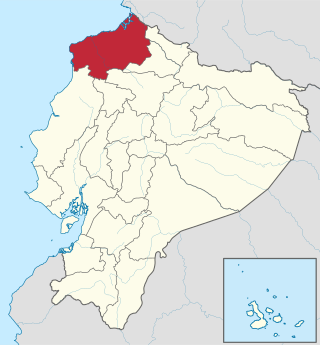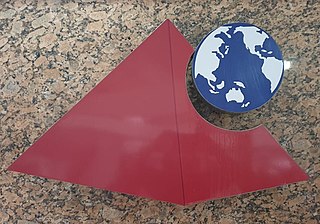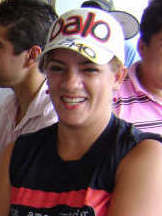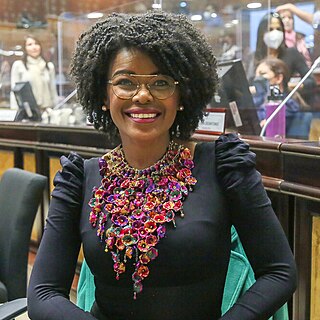
Latin American cuisine is the typical foods, beverages, and cooking styles common to many of the countries and cultures in Latin America. Latin America is a highly racially, ethnically, and geographically diverse with varying cuisines. Some items typical of Latin American cuisine include maize-based dishes arepas, empanadas, pupusas, tacos, tamales, tortillas and various salsas and other condiments. Sofrito, a culinary term that originally referred to a specific combination of sautéed or braised aromatics, exists in Latin American cuisine. It refers to a sauce of tomatoes, roasted bell peppers, garlic, onions and herbs. Rice, corn, pasta, bread, plantain, potato, yucca, and beans are also staples in Latin American cuisine.

Esmeraldas is a province in northwestern Ecuador. The capital is Esmeraldas.

Ecuadorian cuisine is diverse, varying with altitude and associated agricultural conditions. Ecuadorian cuisine is an amalgamation of Spanish, Andean, and Amazonian cuisines and to a lesser degree Italian, Lebanese, African, and Chinese. Beef, chicken, and seafood are popular in the coastal regions, especially ceviche, and are typically served with carbohydrate-rich foods, such as rice accompanied with lentils, pasta, or plantain. In the mountainous regions pork, chicken, beef and cuy are popular and are often served with rice, maize, or potatoes. A popular street food in mountainous regions is hornado, consisting of potatoes served with roasted pig. Some examples of Ecuadorian cuisine in general include patacones, llapingachos, and seco de chivo. A wide variety of fresh fruit is available, particularly at lower altitudes, including granadilla, passionfruit, naranjilla, several types of banana, uvilla, taxo, and tree tomato.

Universidad Del Pacífico – Ecuador : Escuela de Negocios (UPACIFICO) is an Ecuadorian non-profit private university.

Mazamorra is the name for numerous traditional dishes from the Iberian Peninsula and Hispanic America.

Chicha morada is a beverage originated in the Andean regions of Perú but is currently consumed at a national level.

T'anta wawa is a type of sweet roll shaped and decorated in the form of a small child or infant. They are generally made of wheat and sometimes contain a sweet filling. They are made and eaten as part of ancestral rites in Andean regions of Bolivia, Ecuador, Peru, the south of Colombia, and the north of Argentina, mainly on All Souls' Day, but also as part of agricultural festivals, carnivals, and Christmas.
Nicolás Kingman Riofrío was an Ecuadorian journalist, writer and politician.

Máchica is a type of flour made from ground toasted barley or other toasted grains. It is used in Bolivian, Ecuadorian and Peruvian cuisine.
Ángela Maritza Bonilla Zapata is an Ecuadorian model and beauty pageant titleholder who won Miss Earth Ecuador 2015. She also won Miss Global 2016 representing Ecuador.

The Our Lady of Mercy Cathedral also called Babahoyo Cathedral It is a religious building is located opposite the 24 de Mayo park, in the city of Babahoyo capital of Canton Babahoyo in the province of Los Rios, in the heart of the South American country of Ecuador.
Enrique Chediak is an Ecuadorian cinematographer.

María Gabriela Pazmiño Pino, nicknamed Gaby, is an Ecuadorian television presenter, cheerleader, dancer, and politician. She is married to Abdalá Bucaram Jr., with whom she has had four children.
Fanny León Cordero is an Ecuadorian jurist and poet. In 1947, she became the first female judge in Ecuador.
Blanca Martínez Mera was an Ecuadorian writer and teacher. With the publication of her book En la paz del campo in 1940, she became the first woman to publish a novel in Ecuador.
Las Tres Marías were an Afro-Ecuadorian musical trio.

María Mercedes Pacheco is an Ecuadorian actress known for her portrayals of various television characters, as well as her work as a presenter for some TV programs. Pacheco is also known for playing 'Estrellita Vespertina' in the comedy series El Combo Amarillo on Ecuavisa.

Janeth Paola Cabezas Castillo is an Ecuadorian politician and former television presenter. She was the Governor of Esmeraldas Province from 2013 to 2016 and is a current member of Ecuador's National Assembly for the Citizen Revolution Movement (RC). Cabezas was elected leader of the largest political coalition in the 2021 National Assembly, the Union for Hope (UNES).













